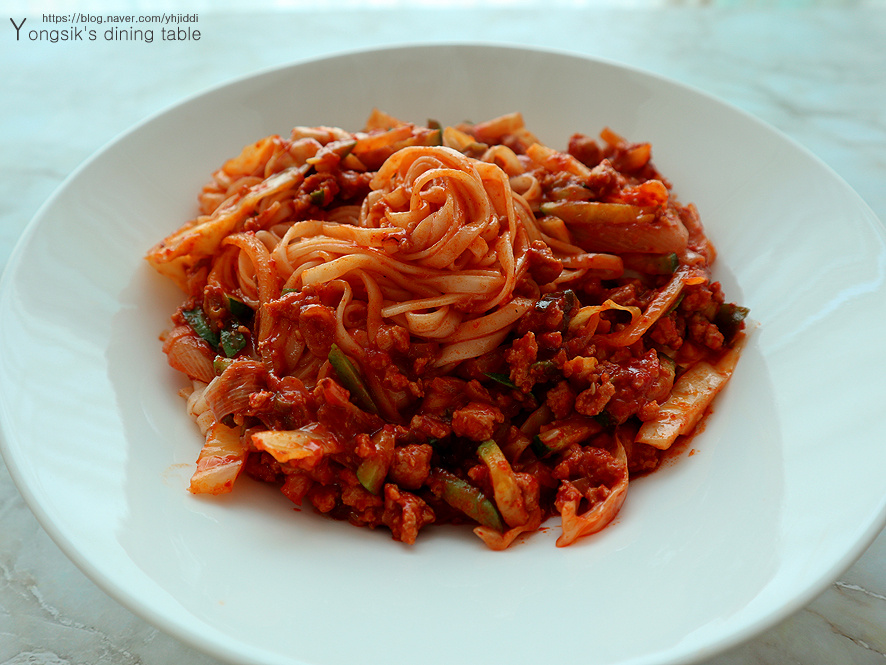Chinese-Style Jeyuk Noodles
Baek Jong-won’s Chinese-Style Jeyuk Noodles Recipe from ‘Matnamui Gwangjang’

This is Baek Jong-won’s easy-to-follow recipe for Chinese-style Jeyuk Noodles. It features plenty of vegetables and a savory, slightly sweet, and spicy pork sauce, making it a delicious alternative to rice.
Chinese-Style Jeyuk Stir-fry- 2 Tbsp cooking oil
- 1/3 cup onion
- 1/3 cup green onion
- 2/3 cup cabbage
- 2/3 cup zucchini
- 1 serving of Kalguksu noodles or your preferred noodles
Chinese-Style Jeyuk Sauce- 1 cup ground pork (hind leg is recommended)
- 5 Tbsp cooking oil
- 1/2 cup green onion
- 1 Tbsp minced garlic
- 1 Tbsp soy sauce
- 1.5 Tbsp sugar
- 1 Tbsp coarse gochugaru (Korean chili flakes)
- 1 Tbsp fine gochugaru (Korean chili flakes)
- 1 Tbsp doenjang (fermented soybean paste)
- 4 Tbsp gochujang (Korean chili paste)
- 1/4 Tbsp salt
- A pinch of black pepper
- 2 cups water
- 1/3 Tbsp MSG (optional)
- 1 cup ground pork (hind leg is recommended)
- 5 Tbsp cooking oil
- 1/2 cup green onion
- 1 Tbsp minced garlic
- 1 Tbsp soy sauce
- 1.5 Tbsp sugar
- 1 Tbsp coarse gochugaru (Korean chili flakes)
- 1 Tbsp fine gochugaru (Korean chili flakes)
- 1 Tbsp doenjang (fermented soybean paste)
- 4 Tbsp gochujang (Korean chili paste)
- 1/4 Tbsp salt
- A pinch of black pepper
- 2 cups water
- 1/3 Tbsp MSG (optional)
Cooking Instructions
Step 1
First, prepare the ingredients for the Chinese-style Jeyuk Noodles. Onion, cabbage, and green onions are essential. Zucchini can be omitted if you don’t have it or prefer not to use it. Using ground pork from the hind leg will result in a more delicious dish.

Step 2
Prepare about 1 large green onion. Finely chop some of it for making green onion oil, and slice the rest lengthwise to stir-fry with the vegetables later.

Step 3
Heat cooking oil in a pan and add the chopped green onions to start making green onion oil. Before the green onions turn golden brown, immediately add the ground pork and stir-fry together.

Step 4
Stir-fry thoroughly until all the moisture from the green onions and pork has evaporated and the pork is crumbly. This process helps to remove any gamey smell and enhance the flavor.

Step 5
Once you see enough oil rendering from the pork and green onions, add the sugar. Stir-fry the sugar until it slightly caramelizes in the oil, adding a rich sweetness.

Step 6
When the pork is nicely browned and the sweetness from the sugar is released, add the soy sauce and stir-fry to infuse a fragrant aroma.

Step 7
Next, add the gochujang, doenjang, and minced garlic. Mix them well with the pork and other ingredients until everything is evenly coated.

Step 8
Reduce the heat to medium-low and stir-fry to dissolve the gochujang and doenjang smoothly into the sauce without clumping. This step develops the deep flavor of the sauce.

Step 9
Now, add the coarse and fine gochugaru. If you don’t have fine gochugaru, using only coarse gochugaru is perfectly fine.

Step 10
Be careful not to burn the gochugaru while stir-frying, as burnt chili flakes can impart a bitter taste and ruin the sauce. After adding the gochugaru, stir-fry quickly and immediately pour in the water to prevent burning.

Step 11
After adding the water, generously sprinkle in the black pepper. Black pepper helps to balance the spiciness of the Jeyuk, so don’t forget to add it.

Step 12
Once the sauce begins to simmer, adjust the heat and cook slightly longer until it reaches your desired consistency. Avoid reducing it too much; a moderate thickness is best.

Step 13
Taste the sauce and adjust the seasoning with salt if needed. Since the Jeyuk noodles will be mixed with vegetables, making the sauce slightly saltier ensures the final dish is perfectly seasoned.

Step 14
You can use any type of noodles, such as Kalguksu, Jungmyeon, Somyeon, or Udon. Baek Jong-won used Kalguksu noodles, but Jungmyeon is used in this recipe.

Step 15
After boiling the noodles, don’t discard the noodle water. Set it aside. Rinse the boiled noodles under cold water to cool them down, then set them aside.

Step 16
Pour some of the warm noodle water back onto the noodles to ‘toe-gyeom’ (warm them up by rinsing with hot water). This step makes the noodles softer and keeps them warm. Drain the noodles and place them in a colander.

Step 17
Place the ‘toe-gyeom’-ed noodles in a serving bowl. Now, let’s prepare the stir-fried Jeyuk topping.

Step 18
Prepare another pan, add a generous amount of cooking oil, and heat it until very hot. Stir-frying quickly over high heat will keep the vegetables crisp.

Step 19
Add the onion and lengthwise sliced green onions to the very hot pan first. Stir-fry them quickly over high heat until they are slightly charred, as shown in the picture. This process enhances the flavor of the vegetables.

Step 20
Once the onion and green onions are partially stir-fried, add the zucchini and cabbage and stir-fry them together quickly.

Step 21
As the vegetables begin to soften slightly, pour in the prepared Chinese-style Jeyuk sauce. Adjust the amount of sauce according to the amount of noodles you have prepared. Approximately 4 ladles were used in this recipe.

Step 22
Reduce the heat to medium-low and simmer just until the vegetables are slightly tender. Be careful not to overcook, or the vegetables will become mushy. This completes the preparation.

Step 23
Finally, generously top the warm noodles prepared earlier with the delicious stir-fried Chinese-style Jeyuk.

Step 24
Keep the sauce prepared in advance for days when you don’t feel like cooking. You can quickly stir-fry noodles and top them with this sauce for a fantastic weekend lunch! Enjoy your meal!




